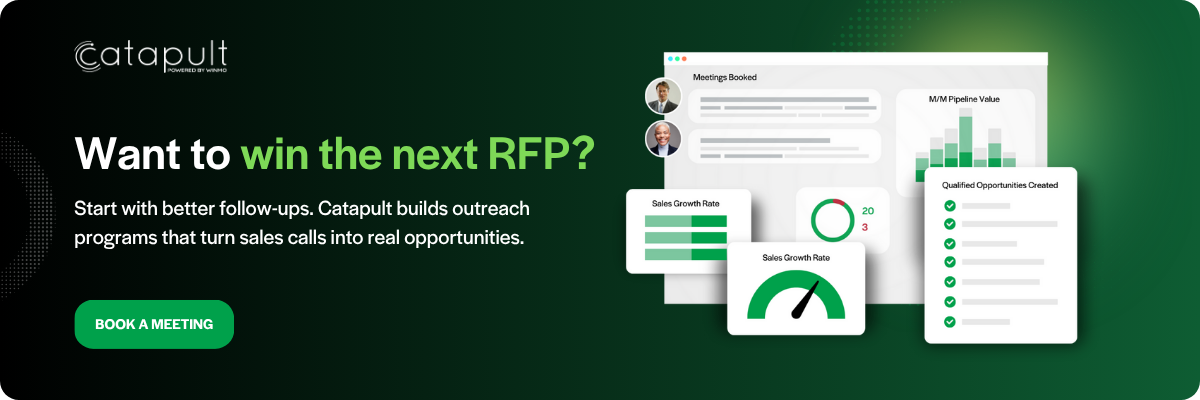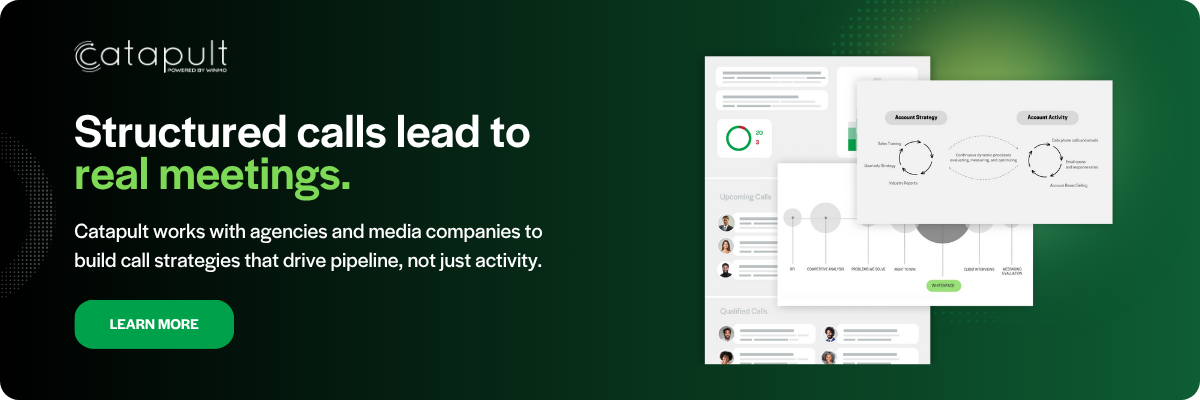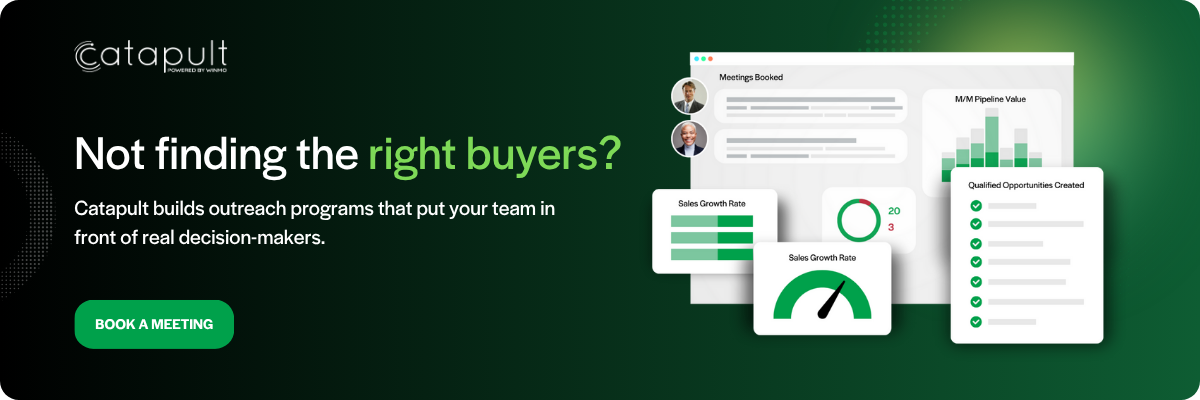TL;DR
- What this blog covers: A step-by-step framework to build effective sales call plans and time outreach for maximum response and conversion.
- Why it matters: Brand decision makers are harder to reach than ever. Without structure and timing, even great outreach falls flat.
- What you’ll identify: Gaps in your call approach, messaging, follow-up cadence, and timing that may be limiting your ability to book meetings and advance deals.
- What’s included: A six-step sales call planning model, timing best practices, discovery questions, objection strategies, and a customizable call structure.
- Who it’s for: Business development leads, and revenue teams looking to improve outreach consistency and book more meetings with brand decision-makers.
Brand decision-makers are getting harder to reach. Their calendars are tighter, their inboxes are more crowded, and their attention is stretched thin. Executives now receive an average of 120 emails a day, and that number climbs with the size and complexity of their organization.
With email channels saturated, the phone remains one of the few ways to create direct, unfiltered connection. Calls continue to outperform when it comes to sparking real conversations. In fact, 82% of buyers have accepted meetings that began with a cold call. But not just any call will land.
The sales teams breaking through prepare differently. They rely on proactive sales and thoughtful call plans to quickly earn attention and build trust.
This guide walks through a practical model for improving sales call performance. It includes a six-step planning framework, a customizable call planning template, and tactical recommendations to keep outreach relevant, timely, and effective throughout the sales cycle.
What Is a Sales Call Plan?
A sales call plan acts as a strategic map for each conversation. It begins with careful research and ends with planned next steps, guiding every interaction toward a clear objective. Without this planning, conversations can drift or repeat mistakes. A well-designed sales call plan keeps things focused, productive, and oriented around buyer needs.
This level of preparation is what separates reactive sellers from those running a proactive sales motion. The best teams follow a consistent sales call planning process that brings discipline, relevance, and results to every interaction. If you’re asking how to plan a sales call that earns attention and drives momentum, start here.

How to Plan a Sales Call in 6 Steps
So, how do you plan a sales call? First, it’s important to know that the best sales call plans strike a balance between structure and flexibility, with each part of the process contributing to a focused and relevant conversation that advances the relationship. The model below outlines how to prepare, guide, and advance your sales calls with clarity, whether it’s your first contact or a critical mid-funnel meeting. Use these components as a foundation you can scale across the team.
1. Research and set your objective
Start by gathering context around the company’s strategy, marketing activity, and recent leadership or funding updates. That research helps shape a specific and measurable call objective, defining what a successful conversation looks like. A clear objective keeps the interaction on track and gives the buyer a reason to engage.
- Identify three insights that influence your approach
- Define a SMART call goal (Specific, Measurable, Achievable, Relevant, Time-bound)
- Tie the objective directly to the buyer’s role or current initiatives
2. Use the CROC framework
CROC (Contact, Reason, Objective, Conclusion) gives your conversation structure without feeling rigid. It’s especially effective in early calls where time is tight and clarity matters. Using a clear format keeps the message focused and helps guide the buyer through the conversation.
- Craft a strong opener that establishes why you’re reaching out
- Move into discovery with relevant context
- Wrap up by confirming what was discussed and what comes next
3. Share a simple agenda
A brief agenda signals professionalism and respects the buyer’s time. You can share it in the calendar invite or open with it during the call. Outlining the flow in advance helps create alignment and allows space for real conversation (not just a pitch).
- Use 1–2 sentences to outline the call
- Mention how you’ll structure the time: intro, goals, alignment, next steps
- Reference the agenda as needed to keep the conversation moving
4. Personalize discovery questions
Tailored discovery shows you’ve done your homework. Questions should reflect the buyer’s role, vertical, and recent business activity and avoid generic prompts that miss the mark. The discovery call’s goal is to uncover what’s changing, where the challenges lie, and what success looks like from their side of the table.
- Build 5–10 open-ended questions specific to the industry or function
- Probe into recent campaigns, media mix shifts, or performance gaps
- Adapt based on how the conversation unfolds
5. Prepare for objections
Planning for pushback creates confidence. Most objections fall into common categories like timing, budget, or bandwidth, so it pays to be ready with thoughtful responses. The key is to treat objections as part of the dialogue, shifting from reactive to proactive sales, and not a reason to retreat.
- Identify the top 2–3 concerns you’re likely to hear
- Draft short, value-based responses that acknowledge and redirect
- Use examples or relevant metrics to reinforce credibility
6. Confirm clear next actions
Close the conversation by summarizing what was covered and locking in a specific next step. Open-ended follow-ups tend to lose momentum. A clearly defined next action sets expectations and moves the opportunity closer to a decision, especially when the goal is positioning your team to be part of the short list and eventually winning your next RFP.
- Restate the main points discussed
- Confirm timing, meeting format, and any additional stakeholders
- Send a follow-up note that reinforces alignment and outlines next steps
Each element of this planning model supports consistency, sharpens delivery, and helps sellers stay in control of the conversation, creating more predictable outcomes and stronger relationships with decision-makers.
Optimize Your Outreach Timing
Even a well-crafted message can be ignored if it arrives at the wrong time. Understanding when your ideal prospects are most receptive can improve meeting conversion and ensure your effort doesn’t go to waste. This section offers data-backed guidance and strategic practices to help sales teams land messages when decision-makers are most likely to see and respond.
1. Best days to make sales calls
Recent studies across sales platforms show that engagement peaks midweek.
- Tuesday through Thursday earn the highest open and response rates across B2B outreach channels, with Tuesday often leading all overall metrics.
- Mondays are often overloaded with catch-up tasks, reducing attention to new outreach.
- Fridays tend to follow a productivity slump, with engagement dropping as the weekend approaches.
2. Best times to make sales calls
Aligning outreach with buyer behavior within the day increases visibility and improves response chances.
- Morning window (around 8–11 AM): Prospects are checking email soon after starting their day—this slot sees the highest open and reply rates.
- Early afternoon (between 1–3 PM): A second peak as people transition out of lunch and reinvest focus. Attention stays strong through the early afternoon.
- Avoid late afternoon (after 4 PM): Connection rates for calls drop sharply and emails often go unread by end-of-day.
3. Best sales call follow-up and personalization tactics
Follow-up is where consistency becomes measurable success.
- Utilize multi-channel outreach (combining email, LinkedIn, and phone calls) to increase visibility without relying on a single channel. It can also boost reply rates up to 160%.
- Personalize at every touchpoint by referencing prospect-specific signals like recent product launches or vertical shifts.
- Reserve three to four touches at strategic intervals; a well-planned cadence can double or triple reply rates. Consistency beats cleverness.
Advanced Tools to Elevate Sales Calls
Investing in the right frameworks and tools both improves individual performance and scales across the team. This section introduces strategies that embed repeatable excellence into every call like insight-driven coaching, call recording, team feedback cycles, and outreach tech, that help you stay in rhythm and ahead of the competition.
1. Pre‑call planning research tools
A standardized planning doc or CRM template ensures reps prep every call with the same rigor. It reinforces consistency and prioritizes the research, objectives, discovery questions, objections, and next-step planning before the call starts.
- Prep each planned call with a fillable checklist to ensure consistency across research, objectives, and discovery.
- Make the checklist accessible in your CRM or shared folder so managers can easily review prep quality.
- Link the checklist to calendar invites for quick reference right before the conversation.
- Tap into WinmoAnswers for AI-powered insights on decision-makers, brand shifts, campaigns, and leadership moves, giving your sales call plan a fast, informed edge.
- Apply Humantic AI to layer in buyer personality profiles and communication cues, tailoring every sales call plan with precision.
2. Call recording and review tools
Recording sales calls opens the door for performance feedback and pattern analysis. Platforms like Gong, Chorus, or Einstein Conversation Insights enable teams to track pacing, tone, and question quality, revealing coaching opportunities that lead to real improvements. Coaching programs aligned to recorded calls have shown to increase win rates by 17–28% and boost productivity by up to 88%.
- Review random call samples each week with coaching leaders
- Evaluate mastery of frameworks like CROC, agenda-setting, and discovery flow
- Highlight both strong examples and common pitfalls for team learning
3. Ongoing coaching and team development tools
Regular coaching check-ins help reinforce new skills and prevent pitch fatigue. Teams that coach weekly or monthly are far more likely to closely follow sales process and close more deals. In fact, companies with dynamic coaching routines hit quota attainment rates of 91%, compared to 85% for teams with informal coaching.
- Schedule monthly one-on-one or peer review sessions
- Use roleplay to simulate objection handling and agenda delivery
- Track follow-up performance, new meeting booking rates, and close ratios
4. Outreach timing monitoring tools
Tools like Outreach, Salesloft, and Klenty enable teams to schedule emails based on buyer time zone and local behavior, and automate follow-up sequences. Automation speeds up deployment without sacrificing personalization and keeps cadence consistent across reps.
- Set up multi-step sequences with timed sends
- Use analytics dashboards to optimize open and reply windows
- Combine templates with variable inserts to maintain personalization at scale
5. Flexible talk tracks and messaging blocks
Instead of rigid scripts, build vertical-specific messaging blocks (with openers, objections, and closing statements) that reps can adapt. This retains structure while giving sellers the freedom to own the delivery.
- Draft reusable talk modules by vertical and buyer persona
- Update blocks quarterly based on trends, objections, and case studies
- Coach on tone and adaptation, not word-for-word recitation
- Use tools like AirDeck or Spekit to deliver these messaging modules directly within workflows, allowing reps to access and adapt key messaging without disrupting the flow of their sales call plan.
6. Follow up and omnichannel outreach tools
Follow-up is where momentum is won or lost, yet many teams drop the ball after the first touch. Automating this part of your sales call plan ensures consistency without sacrificing personalization.
- Use HubSpot Sales Sequences or Apollo.ai to automate personalized follow-up emails and ensure no prospect falls through the cracks.
- Automate LinkedIn outreach with tools like Dripify, helping your team scale touchpoints and stay present across channels. Cold prospects often require 20-50 touchpoints before a response.
- Use AI-powered platforms like RedCar to run autonomous outbound, handling research, outreach, qualification, and even meeting booking, so your team can stay focused on high-value conversations.
- Integrate these tools into your CRM to align with your broader sales call planning process and reinforce a proactive sales rhythm.
Final Thoughts: Structure Wins Meetings. Timing Closes Them.
Strong sales calls are built on preparation, relevance, and well-timed execution. When your team commits to consistent sales call planning, conversations move forward with purpose.
Catapult helps you run a fully “done for you” proactive sales program. Our team leads the outreach, supplies the tools, and manages every step, from research to call delivery. We apply proven frameworks and real-time data to ensure each call starts with a clear plan and ends with meaningful progress.
If your team is ready to improve performance and simplify how to plan a sales call, we’re built for that. Let’s talk through how to tailor your sales strategy to land meetings with the right brand decision-makers. Book a meeting with our team to see what’s possible when preparation meets precision.
FAQ
A sales call plan should include research on the prospect, a clear objective for the call, a basic agenda, key discovery questions, likely objections, and defined next steps.
The highest reply rates are typically between 7–11 AM and 12–3 PM, Tuesday through Thursday, based on decision-maker email behavior.
Personalize every message, follow up across channels, and time outreach based on the buyer’s local business hours to improve visibility and engagement.
CROC stands for Contact, Reason, Objective, Conclusion, a simple framework to structure calls, keep them focused, and improve conversion.
Lorem ipsum dolor sit amet, consectetur adipiscing elit. Ut elit tellus, luctus nec ullamcorper mattis, pulvinar dapibus leo.
Lorem ipsum dolor sit amet, consectetur adipiscing elit. Ut elit tellus, luctus nec ullamcorper mattis, pulvinar dapibus leo.




